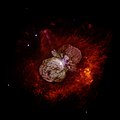Պատկեր:Eta Carinae.jpg
Արտաքին տեսք

Նախադիտման չափ՝ 600 × 599 պիքսել։ Այլ թույլտվությաններ: 240 × 240 պիքսել | 480 × 480 պիքսել | 769 × 768 պիքսել | 1025 × 1024 պիքսել | 2015 × 2013 պիքսել.
Սկզբնական նիշք (2015 × 2013 փիքսել, նիշքի չափը՝ 163 ԿԲ, MIME-տեսակը՝ image/jpeg)
Նիշքի պատմություն
Մատնահարեք օրվան/ժամին՝ նիշքի այդ պահին տեսքը դիտելու համար։
| Օր/Ժամ | Մանրապատկեր | Օբյեկտի չափը | Մասնակից | Մեկնաբանություն | |
|---|---|---|---|---|---|
| ընթացիկ | 09:41, 18 Դեկտեմբերի 2017 |  | 2015 × 2013 (163 ԿԲ) | The NMI User | Reverted to version as of 14:14, 1 May 2008 (UTC) |
| 14:45, 13 Մարտի 2017 |  | 3000 × 2998 (1,18 ՄԲ) | Leogorgon | larger file size | |
| 14:14, 1 Մայիսի 2008 |  | 2015 × 2013 (163 ԿԲ) | Vol de nuit | {{Information |Description=(NASA News Release) A huge, billowing pair of gas and dust clouds are captured in this stunning NASA Hubble Space Telescope image of the supermassive star Eta Carinae. Using a combination of image processing techniques (ditheri |
Նիշքի օգտագործում
Այս նիշքին օգտագործող էջեր չկան։
Նիշքի համընդհանուր օգտագործում
Հետևյալ այլ վիքիները օգտագործում են այս նիշքը՝
- Օգտագործումը da.wikipedia.org կայքում
- Օգտագործումը en.wikipedia.org կայքում
- Star
- Eta Carinae
- Wikipedia:Selected anniversaries/March 11
- Wikipedia:Today's featured article/March 2017
- Wikipedia:WikiProject Wikipack Africa Content/Wikipedia:Showcase
- Wikipedia:WikiProject WikiFundi Content/Eta Carinae
- Wikipedia:Today's featured article/requests/Eta Carinae
- Wikipedia:Today's featured article/March 12, 2017
- Wikipedia:Main Page history/2017 March 12
- Wikipedia:WikiProject WikiFundi Content/Wikipedia:Showcase
- Wikipedia:Main Page history/2022 March 11
- Wikipedia:Main Page history/2022 March 11b
- Wikipedia:Main Page history/2023 March 11
- Wikipedia:Main Page history/2023 March 11b
- User:2003 LN6/sandbox/Eta Carinae variable
- List of luminous blue variable stars
- Օգտագործումը en.wikiversity.org կայքում
- User:Marshallsumter/Radiation astronomy2/Visuals
- User:Marshallsumter/Radiation astronomy2/Violets
- Stars/Astronomy
- User:Marshallsumter/Radiation astronomy2/Violets/Quiz
- Stars/Sun/Astronomy/Quiz
- User:Marshallsumter/Radiation astronomy/Courses/Principles/Hourly 2
- User:Marshallsumter/Radiation astronomy/Courses/Principles/Final quiz
- Draft:Original research/Io/Quiz
- Titan/Quiz
- Stars/Solar systems/Quiz
- Moon/Quiz
- Earth/Quiz
- User:Marshallsumter/Radiation astronomy/Colors/Quiz
- Volcanoes/Io/Quiz
- Stars/Violets
- User:Marshallsumter/Radiation astronomy2/Stars
- Stars/Violets/Quiz
- Օգտագործումը es.wikipedia.org կայքում
- Օգտագործումը fr.wikipedia.org կայքում
- Օգտագործումը hi.wikipedia.org կայքում
- Օգտագործումը it.wikibooks.org կայքում
- Օգտագործումը la.wikipedia.org կայքում
- Օգտագործումը mk.wikipedia.org կայքում
- Օգտագործումը ms.wikipedia.org կայքում
- Օգտագործումը my.wikipedia.org կայքում
- Օգտագործումը oc.wikipedia.org կայքում
- Օգտագործումը ru.wikipedia.org կայքում
- Օգտագործումը sk.wikipedia.org կայքում
- Օգտագործումը sr.wikipedia.org կայքում
- Օգտագործումը th.wikipedia.org կայքում
Տեսնել այս նիշքի ավելի համընդհանուր օգտագործումը:

